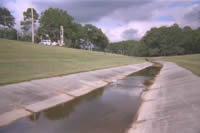| |
Processes Affecting the Natural Attenuation of Fuel Oxygenates in Ground
Water: Laurel Bay, South Carolina
 |
Ground-water at the Laurel Bay
Site discharges to this concrete-lined drainage ditch where highly
efficient biodegradation takes place in the sediments under the
ditch. |
Methyl tertiary-butyl
ether (MTBE) is just one of the hundreds of compounds in gasoline
that we pump into cars across this Nation every day. However, MTBE has
the notoriety of being very soluble in water and can comprise up to 15%
by volume of gasoline. As such, releases of gasoline containing MTBE to
ground-water systems at leaky underground storage tank (LUST) sites are
often characterized by MTBE concentrations that are considerably higher
than those of either benzene or toluene, the most soluble aromatic hydrocarbons
in gasoline (each about 1 - 2% of gasoline). As a result of this higher
solubility and volume, plumes of MTBE contamination in some ground-water
systems can often be over 1,000 ft long.
 |
|
A leaking underground storage
tank at the Laurel Bay site was located behind the gasoline station
to the far right, and the oak trees.
|
|
Gasoline that contained the widely used fuel
oxygenate MTBE was released to a shallow water-table aquifer
from an underground storage tank at a gasoline station near Beaufort,
SC, in the late 1980s. Since 1993, a team of USGS researchers have
examined the natural
attenuation and fate of MTBE from this spill in the following
compartments of the hydrosphere:
|
- in ground water, compared to the fate of the most mobile aromatic
petroleum hydrocarbon (benzene), using laboratory, field, and
numerical modeling approaches;
- in ground water, to determine if the biodegradation of MTBE
leads to the production of intermediate breakdown compounds, such
as tertiary butyl alcohol (TBA);
- in ground water under oxic and anoxic conditions;
- at naturally occurring, hydrologic redox interfaces, such as
where anoxic ground water containing MTBE discharges to oxic surface-water
systems;
- at artificially engineered redox interfaces, where oxygen is
added to anoxic aquifers containing MTBE;
- in the unsaturated
zone, which contains MTBE vapors from contaminant sources
near the water table, and;
- in trees growing above an MTBE plume and using this gasoline-contaminated
ground water as a source of transpirational water.
|
Related Headlines
Recent Meetings
- USGS and Virginia Tech will present the NGWA's short course "Estimating
Times of Remediation Associated with Monitored Natural Attenuation and
Contaminant Source Removal," Columbus, Ohio, November 3-4,
2003
- USGS co-conducts short course on "Use
of Bioremediation Technologies at Oxygenate-Impacted Sites"
at the Seventh International Symposium on In Situ and On-Site Bioremediation
in Orlando, Florida, on June 6, 2003.
- USGS and Virginia Tech will present the short course "Estimating
Remediation Timeframes for Monitored Natural Attenuation (MNA)"
at the In Situ and On-Site Bioremediation Symposium, Orlando, Florida,
June 2-5, 2003
Overview of Research Accomplishments
Project Remediation Related Activities
More Information
Additional USGS Information on MTBE
Additional Research at the Laurel Bay Site
Related Research Projects
Other Hydrocarbon Remediation Related Activates
Back to Investigations
Page
|